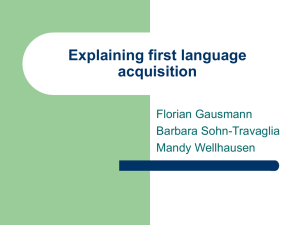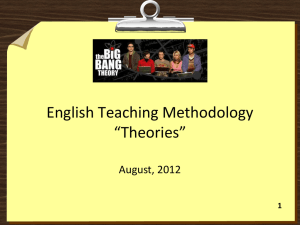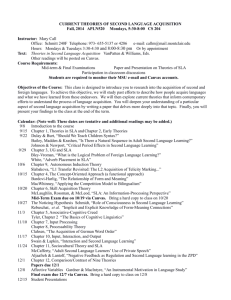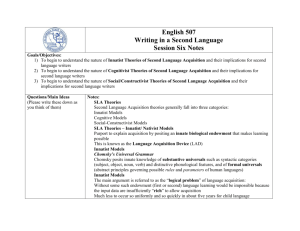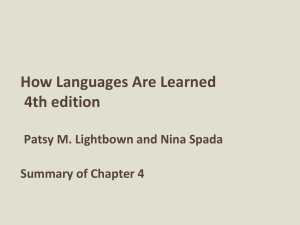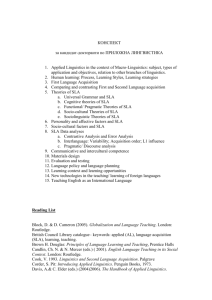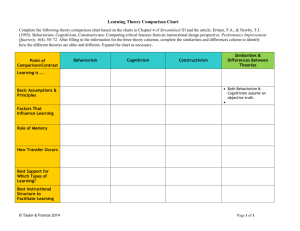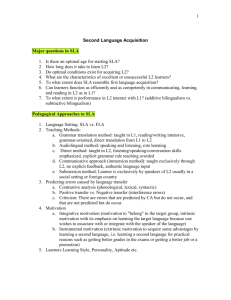English 418 Second Language Acquisition Session Twenty One
advertisement
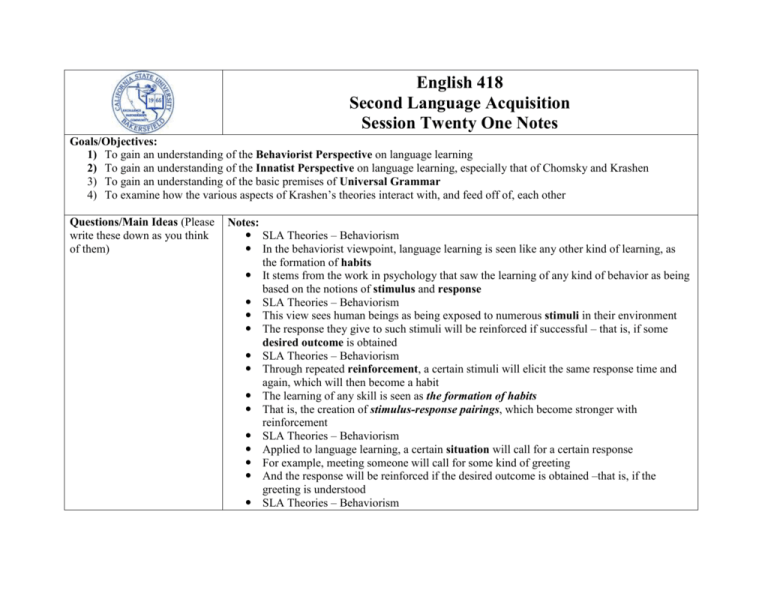
English 418 Second Language Acquisition Session Twenty One Notes Goals/Objectives: 1) To gain an understanding of the Behaviorist Perspective on language learning 2) To gain an understanding of the Innatist Perspective on language learning, especially that of Chomsky and Krashen 3) To gain an understanding of the basic premises of Universal Grammar 4) To examine how the various aspects of Krashen’s theories interact with, and feed off of, each other Questions/Main Ideas (Please write these down as you think of them) Notes: SLA Theories – Behaviorism In the behaviorist viewpoint, language learning is seen like any other kind of learning, as the formation of habits It stems from the work in psychology that saw the learning of any kind of behavior as being based on the notions of stimulus and response SLA Theories – Behaviorism This view sees human beings as being exposed to numerous stimuli in their environment The response they give to such stimuli will be reinforced if successful – that is, if some desired outcome is obtained SLA Theories – Behaviorism Through repeated reinforcement, a certain stimuli will elicit the same response time and again, which will then become a habit The learning of any skill is seen as the formation of habits That is, the creation of stimulus-response pairings, which become stronger with reinforcement SLA Theories – Behaviorism Applied to language learning, a certain situation will call for a certain response For example, meeting someone will call for some kind of greeting And the response will be reinforced if the desired outcome is obtained –that is, if the greeting is understood SLA Theories – Behaviorism In the case of communication breakdown, the particular response will not be reinforced, and the learner will abandon it in favor of a response that it is hoped will be successful and therefore reinforced SLA Theories – Behaviorism All we have to do is learn a set of new habits as we learn to respond to stimuli in our environment When learning a second language, however, we run into problems We already have a set of well-established responses in our mother tongue SLA Theories – Behaviorism The L2 learning process therefore involves replacing those habits with a set of new ones The complication is that old first language habits interfere with this process, either helping or inhibiting it SLA Theories – Behaviorism If structures in the second language are similar to those of the first, then learning will take place easily If, however, structures are realized differently in the first and second language, then learning will be difficult SLA Theories – Behaviorism From a teaching point of view, the implications of this approach were twofold: First, it was strongly believed that practice makes perfect In other words, learning would take place by imitating and repeating the same structures time after time SLA Theories – Behaviorism Second, teachers needed to focus their teaching on structures which were believed to be difficult Difficult structures would be those that were different in the first and second languages The logical outcome of such beliefs about the learning process was that: SLA Theories – Behaviorism Effective teaching would concentrate on areas of difference The best pedagogical tool for foreign language teachers was therefore a sound knowledge of those areas Researchers therefore embarked on the huge task of comparing languages in order to pinpoint areas of difference, and therefore difficulty SLA Theories – Behaviorism This was termed Contrastive Analysis Thus teachers were told that “the most effective materials are those based on a scientific description of the language to be learned, carefully compared with a parallel description of the native language of the learner” (Charles Fries) SLA Theories – Behaviorism Starting in the 1950s and continuing into the 1960s, both linguistics and psychology witnessed major developments Linguistics saw a shift away from structural linguistics, which was based on the description of the surface structure of a large corpus of language SLA Theories – Behaviorism To generative linguistics that emphasized the rule-governed and creative nature of human language – initiated by Noam Chomsky In the field of psychology, the pre-eminent role for the environment – which was argued by Skinner – in shaping the child’s learning and behavior SLA Theories – Behaviorism Was losing ground in favor of more developmentalist views of learning, such as Piaget’s cognitive development theory, in which inner forces drive the child, in interaction with the environment The clash came to a head with Chomsky’s review of Skinner’s Verbal Behavior SLA Theories – Behaviorism Chomsky’s criticisms: 1) The creativity of language Children do not learn and produce a large set of sentences, but they routinely create new (original) sentences that they have never learned before This is only possible because they internalize rules rather than strings of words SLA Theories – Behaviorism Extremely common examples include “it breaked” or “Mommy goed,” which clearly show that children are not just copying the language around them Rather they are applying (or perhaps “over-applying”) rules SLA Theories – Behaviorism Chomsky was greatly bothered by the idea that you could compare the behavior of rats in a lab, learning to perform simple tasks, to the behavior of children, learning language without direct teaching, a fundamentally different task because of its sheet complexity and abstractness SLA Theories – Behaviorism 2) Given the complexity and abstractness of linguistic rules (your “mental grammar”), it is amazing that children are able to master them so quickly and efficiently, given the limited input they receive For these reasons, Chomsky claimed that children have an innate faculty that guides them in their language learning SLA Theories – Behaviorism This revolutionary approach to the study of language gave a great stimulus to the field of psycholinguistics and especially to the study of language acquisition What came after was heavily influenced by these ideas SLA Theories – Innatist/ Nativist Models Purport to explain acquisition by positing an innate biological endowment that makes learning possible This is known as the Language Acquisition Device (LAD) Innatist Models To some researchers [Chomsky, Pinker, Krashen] this endowment is “language specific” Thus, Chomsky posits innate knowledge of substantive universals such as syntactic categories (subject, object, noun, verb) and distinctive phonological features, and of formal universals (abstract principles governing possible rules and parameters of human languages) Innatist Models In other (general) nativist theories, [O’Grady, Parker] what is held to be innate consists of general cognitive notions (dependency, adjacency, precedence, continuity, etc.) – out of which grammatical principles are built up and mechanisms used for all kinds of learning, including language learning Innatist Models For others [Dulay and Burt], the innate endowment involves both linguistic principles and general cognitive notions Chomsky is obviously the best known of these, so the language specific model has held the most sway Innatist Models Chomsky’s Universal Grammar (UG) We should first note that Chomsky was talking about “language” in general, not second language acquisition The Chomskyan framework is used to note various factors which purportedly support the idea that humans are innately (genetically) endowed with universal language specific knowledge Innatist Models The main argument is referred to as the “logical problem” of language acquisition: Without some such endowment (first or second) language learning would be impossible because the input data are insufficiently “rich” to allow acquisition Much less to occur so uniformly and so quickly in about five years for child language Innatist Models According to the Chomskyan perspective, the input is deficient, or “poor”, in two ways: First, it is claimed to be degenerate in the sense that it is marred by performance features Examples include: false starts, slips of the tongue, sentence fragments, and ungrammaticality Innatist Models These result from pressures inherent in real-time oral communication Therefore, so the argument goes, it is an inadequate base for language learning Second, and more serious, the input is “degenerate” in various ways Innatist Models Most importantly, it does not contain “negative evidence”: Information from which the learner could work out what is not possible in a given language Innatist Models Overt negative evidence is unavailable because caregivers react to the truth value, not the form, of children’s utterances and rarely correct ungrammatical speech Innatist Models Covert negative evidence is also unavailable, since, even if they hear ungrammatical sentences, they have no way to know which ones are acceptable and which ones unacceptable Hence, the grammars that learners in fact evolve are said to be “underdetermined” by the input Called “poverty of the stimulus” Innatist Models UG assumes that language consists of a set of principles (abstract “rules”) that characterize core grammars of all natural languages However, in addition to principles that are invariable across natural languages, are parameters that vary across languages Innatist Models Cook helps explain: Overall there is a principle that drivers have to keep consistently to one side of the road, which is taken for granted by all drivers in all countries. Exceptions to this principle, such as people driving down motorways on the wrong side, rate stories in the media or car chases in action movies. The principle does not, however, say which side of the road people should drive on (the parameter) Innatist Models A parameter of driving allows the side to be the left side in England and Japan, and the right side in the USA and France The parameter has two values or “settings” – left and right Once a country has opted for one side or the other, it sticks to its choice Innatist Models So, a universal principle and a variable parameter together sum up the essence of driving The principle states the universal requirement on driving: You must choose one side of the road or the other The parameter specifies the variation between countries Innatist Models How does it work in language learning? If children have to learn a complex set of abstractions, there must be something other than the language input to which they are exposed that enables them to learn language with relative ease and speed UG is postulated as an innate language facility that limits the extent to which languages can vary Innatist Models That is, it specifies the limits of a possible language The mental task for learning is therefore greatly reduced if one is equipped with an innate mechanism that constrains possible grammar formation Question? Can you think of examples on the limitations of languages? Innatist Models Critiques: assumes learning is finished by age five: this is simply not true The assumption that certain syntactic principles are unlearnable, and therefore innate, has been challenged Input available to learners is degenerate: this, in fact, is not true, since caregiver speech and language is predominantly well-formed Innatist Models Krashen’s Monitor Model/Monitor Theory One of the best known and most influential Innatist theories in SLA (through the 1970s and 1980s) is Krashen’s Monitor Model Initially not about SLA, but about SL performance Innatist Models In its earliest incarnation, it was an attempt to reconcile two phenomena: First, a generalization from morpheme studies that there existed a statistically significant association between the orders of appearance of certain English grammatical morphemes, accurately supplied in obligatory contexts, in the speech and writing of SL learners of different ages, L1 backgrounds, and conditions Innatist Models Second, disturbances were observed in this “natural order” on certain performance tasks, specifically the reading and writing tasks, as compared to three other listening and speaking tasks Krashen explained this difference by claiming that two separate knowledge systems underlay SL performance Innatist Models The first, and most important, the acquired system, was the product of application by learners of the same (unspecified) language learning abilities children use for first language acquisition Consisted of subconscious knowledge of the SL grammar, like the subconscious knowledge NSs have of their first language Innatist Models The second, (and less important to Krashen), the learned system, was the product of formal instruction (typically classroom language teaching) and comprised conscious knowledge of “easy” SL grammar rules, like subject-verb agreement Innatist Models According to Krashen, the acquired system was typically the only knowledge source speakers could use in real-time communication, when they were attending to meaning, not to form The learned system was only accessible when three conditions were met: Innatist Models 1. There was sufficient time (the task was unspeeded) 2. The learner was focused on form (like during a discrete point grammar test) 3. When the learner “knew” the rule Innatist Models The Natural Order was the surface manifestation of the acquired system Disturbances were caused by the intrusion of the learned system on performance tasks that encouraged its use (like writing or reading) Led to five major claims over a period of time (not all are as equally important): Innatist Models 1] The Acquisition-Learning Hypothesis: States that there are two independent ways of learning a SL: acquisition and learning Acquisition is subconscious (covert) Learning is conscious (overt) Innatist Models 2] The Natural Order Hypothesis: Says that SL rules are acquired in a predictable order, one apparently not determined solely by linguistic complexity, and certainly not in the order in which the items appear in teaching syllabuses IOW, acquisition orders do not reflect instructional sequences Innatist Models 3] The Monitor Hypothesis: Encapsulates a relationship between the acquired system and the learned system The acquired system is the utterance initiator, with the learned system acting in a planning, editing, and correcting function when the three conditions are met Innatist Models 4] The Input Hypothesis: attempts to explain how a learner acquires a SL (Krashen calls it the central claim of Monitor Theory) It maintains that a SL is acquired through processing comprehensible input, that is language that is heard or read and understood Language that is not understood does not help; if it is too advanced, it is just noise in the system Innatist Models If the input is too simple (that is, already learned), it won’t help either Processing along the “natural order” is achieved when a learner at some stage, “i”, of interlanguage development receives comprehensible input that contains structures (lexis, sounds, morphology, syntax, etc.) one step beyond the current stage, or structures at “i + 1” Innatist Models The unknown structure is understood (the necessary precursor for acquisition) through the help of linguistic and extra-linguistic context, knowledge of the world, previously acquired linguistic knowledge, and in a classroom, by means of pictures, translation, and explanation Innatist Models Krashen is assuming a heavy innate endowment to handle acquisition Krashen also assumes that the endowment is “language specific” Innatist Models 5] The Affective Filter Hypothesis: various affective (emotional) factors, (motivation, selfefficacy, anxiety) play a facilitative, but non-causal role in SLA Lack of motivation, high anxiety, etc., can combine to “raise the filter” to form a “mental block” which prevents CI from reaching the LAD and thereby being used for acquisition Innatist Models A negative affective disposition (a filter that is “up”) constitutes a constraint on the successful workings of CI IOW, a positive affect is necessary, but not sufficient, for SLA To Krashen, comprehensible input is the essential ingredient for second-language acquisition Innatist Models All other factors thought to encourage or cause SLA work only when they contribute to comprehensible input and/or a low filter Immersion programs work, because they provide such comprehensible input (language learning in context) Also, children learn languages easily (he says) because they have no affective filter Innatist Models Critiques of Krashen’s Theories: Acquisition vs. Learning: If evidence of an acquired system is fluent, unconscious speech, then it is counterintuitive to hypothesize that nothing learned in a formal situation can ever be a candidate for this use Too many counter-examples: People in classroom settings do in fact generate utterances Innatist Models IOW, there is no evidence that they are actually two different systems The Monitor Hypothesis: Should only be usable in production, (which is based on acquisition) but people in the classroom where they should not actually have any acquisition use the monitor Innatist Models The Input Hypothesis: What is “i” ? What is sufficient quantity? How do we know when the quantity is sufficient or not? IOW, the Input Hypothesis is essentially unoperationalizable Innatist Models Why don’t children have an affective filter? Fails to take into consideration the value of incomprehensible input Summary/Minute Paper:
